 |
Philips mod. L3X02T/00
- Nederland - 1960 - Description - |
 |
 Description
Description Restoration
Restoration |
 |
Descrizione

Restauro  Schemi elettrici |
|
|
|
|||
 |
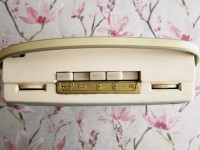 |
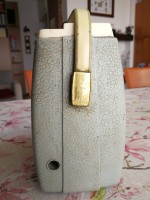 |
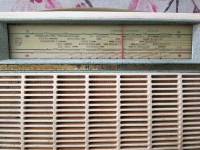 |
 The Philips radio model L3X02T/00W is a portable
transistor receiver built in Netherland in 1960.
The Philips radio model L3X02T/00W is a portable
transistor receiver built in Netherland in 1960.State radio broadcasting in Frequency Modulation had begun in Europe after the Second World War (in Italy RAI began broadcasting in FM in 1950), but initially the diffusion of tube receivers capable of receiving FM was scarce due to the circuit complications that made these radios more expensive than those in Amplitude Modulated, obviously the complications were accentuated if it was necessary to make a portable device equipped with electronic tube device capable of receiving FM as well. From the mid-1950s onwards, with the arrival of the first germanium transistors and their rapid diffusion on the market, it was possible to design small portable receivers. At first the projects concerned only AM radio but later FM could also be added. These radios achieved immediate and great success thanks to their reduced weight and size and the use of low-cost, long-lasting low-voltage batteries. The Philips L3X02T was one of these first portable transistor radios which, in addition to medium and long waves, could also receive the FM range. The L3X02T in my possession has the serial number 64426 and is a superheterodyne using eight Philips germanium transistors: OC171, OC171, OC170, OC170, OC75, OC75, OC74, OC74. The frequency coverage is from 517 to 1612 kHz in Medium Wave, 150 - 405 kHz in Long Wave and 87.5 - 100 MHz in the FM range. The radio is equipped with a ferrite antenna for medium and long waves and a rod antenna for FM. The intermediate frequencies are respectively: 460 kHz for MW/LW and 6750 kHz for FM. The cabinet is made of plastic with a carrying handle. The various controls are in the upper part of the case: a five-key push-button panel includes the power switch, the tone switch and the three range-change buttons: LW, MW, FM; always at the top on the left side there is the volume control and on the right the tuning knob. The magnetodynamic loudspeaker is a three Ohm Philips type AD3414 with diameter 4.133 x 4.133 x 1.65 inch which optimally reproduces the audio signal produced by the power stage equipped with the two OC74s. Power is supplied by six 1.5 V type C dry cell batteries or alternatively by two 4.5 V type 3R12B flat cells. The dimensions are: 10.6 x 7.1 x 3.9 inch and the weight of 4lb 0.0927 oz without batteries. © IK3HIA 2023. |
|||
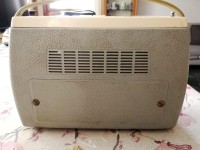 |
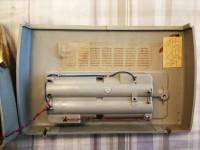 |
 |
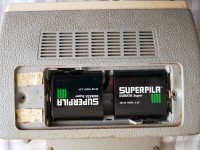 |
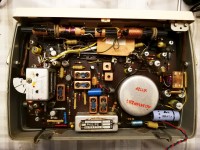 |
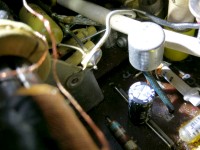 |
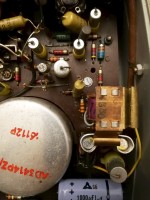 |
 |
|
Return to top of page
|
|||
 La radio Philips modello L3X02T/00W
è un ricevitore portatile a transistor costruito
in Olanda nel 1960.
La radio Philips modello L3X02T/00W
è un ricevitore portatile a transistor costruito
in Olanda nel 1960.Le trasmissioni di radiodiffusione statale in Modulazione di Frequenza erano iniziate in Europa dopo la seconda guerra mondiale (in Italia la RAI iniziò a trasmettere in FM nel 1950), ma inizialmente la diffusione dei ricevitori a valvole atti a ricevere la FM fu scarsa a causa delle complicazioni circuitali che rendevano tali radio più costose di quelle in Ampiezza Modulata, ovviamente le complicazioni si accentuavano se si voleva realizzare un apparecchio portatile a tubi elettronici atto a ricevere anche la FM. Dalla metà degli anni 50 in poi, con l'arrivo dei primi transistor al germanio e la loro rapida diffusione sul mercato, fu possibile progettare ricevitori portatili dalle dimensioni ridotte. Dapprima i progetti riguardarono solo radio AM ma in seguito si poté aggiungere anche la FM. Tali radio ottennero un immediato e grande successo grazie al peso e alle dimensioni ridotte e all'utilizzo di batterie a basso voltaggio dal costo contenuto e di lunga durata. La Philips L3X02T è stata uno di queste prime radio portatili a transistor che oltre oltre alle Onde Medie e Lunghe poteva ricevere anche la gamma FM. La L3X02T in mio possesso ha il numero seriale 64426 ed è una supereterodina che utilizza otto transistor Philips al germanio: OC171, OC171, OC170, OC170, OC75, OC75, OC74, OC74. La copertura in frequenza è da 517 a 1612 kHz nelle Onde Medie, 150 - 405 kHz nelle Onde Lunghe e 87.5 - 100 MHz in gamma FM. La radio è dotata di un'antenna in ferrite per le Onde Medie e Lunghe e di un'antenna a stilo per la FM. Le frequenze intermedie sono rispettivamente: 460 kHz per l'AM e 6750 kHz per la FM. Il mobile è in plastica con maniglia per il trasporto. I vari controlli sono nella parte in alto della valigetta: una pulsantiera con cinque tasti comprende l'interruttore di accensione, quello del tono e i tre pulsanti per il cambio gamma: LW, MW, FM; sempre in alto nella parte sinistra c'è il controllo del volume e a destra la manopola per la sintonia. L'altoparlante magnetodinamico è un Philips tipo AD3414 da tre Ohm con diametro di 10.5x10.5x4.2 cm che riproduce ottimamente il segnale audio prodotto dallo stadio di potenza equipaggiato con i due OC74. L'alimentazione è fornita da sei batterie a secco da 1,5 V tipo C o in alternativa da due pile piatte da 4,5 V tipo 3R12B. Le dimensioni sono: 268 x 180 x 100 mm e il peso di 1,817 Kg senza batterie. © IK3HIA 2023. |
|||
|
Return to top of page
|
|||
|
|
Return to: IK3HIA home page |
|
Return to: Transistor Radio |
|
Go to: Transistor diagrams |